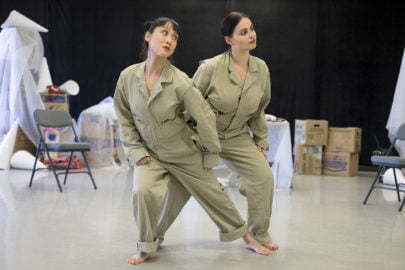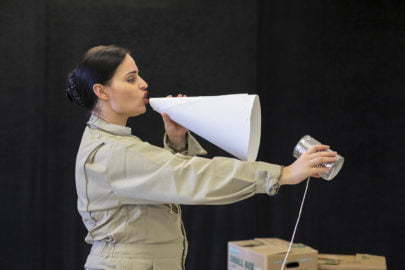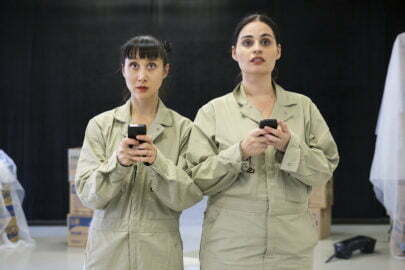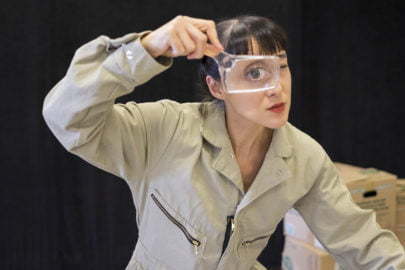If you saw ‘Your Call…’ Part 1 in last year’s Tête à Tête: The Opera Festival you’re in for many surprises this year when you see the complete work. Clocking in at about 55 minutes, ‘Your Call…’ has undergone major transformations.
The biggest and most obvious change is the addition of a second Mezzo Soprano. American mezzo Hai-Ting Chinn joins the cast as a second iteration of ‘The Woman.’ Splitting one character between two performers is a reflection on the unreliability of online identity and the ways we can shape our online image, enhancing or subverting reality.
 You’ll hear a lot of new music in the complete ‘Your Call…’ Having the second voice much more than doubles the musical possibilities. The second voice enriches and deepens the musical texture in a very dramatic way. Both in speaking and singing they share lines, even splitting individual sentences between them as well as singing together.
You’ll hear a lot of new music in the complete ‘Your Call…’ Having the second voice much more than doubles the musical possibilities. The second voice enriches and deepens the musical texture in a very dramatic way. Both in speaking and singing they share lines, even splitting individual sentences between them as well as singing together.
The character of ‘The Woman’ has a relationship to technology that is very intense. Her reliance on technology and fear of human-social interactions overwhelm her existence. And we get the sense that she wouldn’t have it any other way. Over and over again she answers a phone, listens and replies, “Oh no, no, no. You’re confusing this one with the other one.” This becomes a real issue for The Woman. Her only interaction with another human always seems to go wrong. She repeatedly retreats to the safety of her phone, even singing, “A friend you can mute is a friend forever.”
Fundamental elements of communication are getting a deeper look as well. The set and props are made of circles, squares and triangles – fundamental elements of visual communication. Made of Boxes, along with many many megaphones, you’ll see circles (end of a megaphone), squares (boxes), and triangles (megaphones on end). The vowels, a, e, i, o, u, fundamental elements of aural communication, are both spoken and sung as well as being presented in sign language and semaphore signals. And then there are the phones, old and new, big and small, everywhere

S-O-S, the universal signal of distress is a recurring refrain, woven throughout ‘Your Call…’ in Morse code, semaphore signals, sign language and within the score itself. Is this an unconscious cry for help? On the surface she doesn’t appear to want any help. Is this a manifestation of concern from the synthetic voices who see how her over-reliance on technology has taken over her external life? Only The Woman knows for sure.
There is a darkness in ‘Your Call…’ that is juxtaposed with broad physical comedy. We hope that you’ll find it as funny as it is disturbing. The character of The Woman makes everyday gestures into a language of their own. She is clearly unaware that she is expressing herself with her body. She doesn’t need to since her only meaningful relationships are online.

The difference between the internal and external is accentuated throughout the new version of ‘Your Call…’ Spoken text is external, an increasingly desperate attempt to understand and be understood. Sung text is internal, fragmented, jumping randomly from thought to thought. The theatrical ‘fourth wall’ is repeatedly shattered in the performance, always with spoken text. What’s said needs to be heard. What’s sung is bouncing around inside her head.
Overall the new ‘Your Call…’ is bigger, funnier, darker, and more thought provoking. It’s a wild ride across a theatrical landscape that starts inside ‘The Woman’s’ head, weaves its way through the internet and lands on the floor of King’s Place, Hall 2.
Oh, and we’ll ask you to please mute your phones (we’ll be friends forever) but please do Tweet with the hashtag #ycopera during the show. We’ll be doing that from the stage and we want you all to be in on the fun. Hope to see you there, 8 – 9 August!
Lisa J. Coates & Kevin Jones

 BACK
BACK